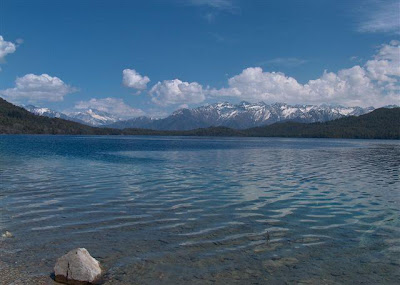
Mount Everest, or Sagarmatha is the highest mountain on Earth, as measured by the height of its summit above sea level. The mountain, which is part of the Himalaya range in High Asia, is located on the border between Nepal and Tibet, China. By the end of the 2006 climbing season there had been 3,050 ascents to the summit by 2,062 individuals, and at least 630 more ascents in 2007.There have been more than 200 deaths on the mountain, where conditions are so difficult that most corpses have been left where they fell; some are visible from standard climbing routes.
Climbers range from experienced mountaineers to relative novices who count on their paid guides to get them to the top. This means climbers are a significant source of tourist revenue for Nepal, whose government also requires all prospective climbers to obtain an expensive permit, costing up to $25,000 (USD) per person.
Radhanath Sikdar, an Indian mathematician and surveyor from Bengal, was the first to identify Everest as the world's highest peak in 1852, using trigonometric calculations based on measurements of "Peak XV" (as it was then known) made with theodolites from 240 km (150 miles) away as part of the Great Trigonometric Survey of India. Measurement could not be made from closer due to a lack of access to Nepal. Peak XV was found to be exactly 29,000 feet (8,839 m) high, but was publicly declared to be 29,002 feet (8,840 m). The arbitrary addition of 2 feet (0.6 m) was to avoid the impression that an exact height of 29,000 feet was nothing more than a rounded estimate.
More recently, the mountain has been found to be 8,848 m (29,028 feet) high, although there is some variation in the measurements. The mountain K2 comes in second at 8,611 m (28,251 ft) high. On May 22, 2005, the People's Republic of China's Everest Expedition Team ascended to the top of the mountain. After several months' measurement and calculation, on October 9, 2005, the PRC's State Bureau of Surveying and Mapping officially announced the height of Everest as 8,844.43 m ± 0.21 m (29,017.16 ± 0.69 ft). They claimed it was the most accurate measurement to date.[9] This height is based on the actual highest point of rock and not on the snow and ice covering it. The Chinese team also measured a snow/ice depth of 3.5 m,[10] which is in agreement with a net elevation of 8,848 m. The snow and ice thickness varies over time, making a definitive height of the snow cap impossible to determine.
Everest was formed about 60 million years ago. It was named after Sir George Everest in 1865 ,the British surveyor-general of India. Once known as Peak 15. Its location is Latitude 27° 59' N.....Longitude 86° 56' E It's summit ridge seperates Nepal and Tibet. First ascent was done by May 29,1953 by Sir Edmund Hillary, NZ and Tenzing Norgay, NP, via the South Col Route. The most dangerous place is Khumbu Ice Fall-19 deaths.Highest cause of death is Avalanches-about a (2:1) ratio over falls.







 Phewa lake is the second largest lake of Nepal and the largest lake of Pokhara Valley. IT is situated at an altitude of 784m at the western edge of Pokhara city near Baidam. It covers an area of about 4.43 sq km with an average depth of about 8.6m, maximum water depth is 19m. The maximum water capacity of the lake is estimated to be 46 million cubic meters. It lies in the valley of Harpan Khola which feeds the lake. On the southern mouth of the lake, at the crown of Pardi River, a dam is built which has nearly doubled the water level. The water of the lake is used for irrigation and electricity generation.
Phewa lake is the second largest lake of Nepal and the largest lake of Pokhara Valley. IT is situated at an altitude of 784m at the western edge of Pokhara city near Baidam. It covers an area of about 4.43 sq km with an average depth of about 8.6m, maximum water depth is 19m. The maximum water capacity of the lake is estimated to be 46 million cubic meters. It lies in the valley of Harpan Khola which feeds the lake. On the southern mouth of the lake, at the crown of Pardi River, a dam is built which has nearly doubled the water level. The water of the lake is used for irrigation and electricity generation.


